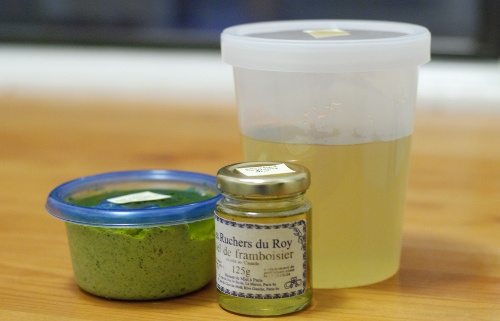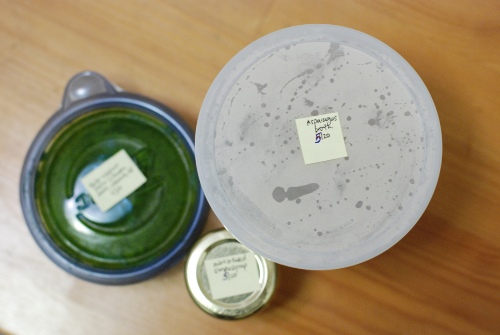 I dunno about you, but I'm feeling more and more compelled to get a composter. It seems ridiculous that I throw away several pounds of biodegradable stems, peelings, cores, pits, seeds, skins, and rinds, when I could compost them instead. I know that composting in urban environments can be challenging: living as we do in the heart of DC, our access to yard space is
I dunno about you, but I'm feeling more and more compelled to get a composter. It seems ridiculous that I throw away several pounds of biodegradable stems, peelings, cores, pits, seeds, skins, and rinds, when I could compost them instead. I know that composting in urban environments can be challenging: living as we do in the heart of DC, our access to yard space is limited nonexistent, and we aren't exactly teeming with the space (or money, for that matter) to install one of those large, expensive all-in-one electric composters. That said, the amount of waste that my one household -- a household of two -- can produce in one week is kind of mindblowing. So I'm considering getting a compost tub, just a little guy for the house. One of the biggest lobbyists for this purchase is our friend Matt, who lives with his wife Bryce around the corner from us, and has kindly volunteered to take our compost if we'll drop it off (right, Matt?). I figure, I've got someone to take the stuff, and I've definitely got room for a little bin in my kitchen: now is as good a time as any to stop wasting and start composting. Huzzah!
Composter in hand, I'll stop throwing away the bits of produce that I tend not to use in cooking. But there's another way to think about limiting waste, one that's near and dear to me as a food blogger, and that's making sure to extract as much flavor as possible from the ingredients we buy. Not only is this best practice for maximizing use of the food we buy, it's also a way to ensure that we make the most of our purchases, which in turn can save all of us a little hard-earned dough.
Within the past two days, I've made broth out of the stems of asparagus, cooked a mint-infused simple syrup with the stems and some leaves of a massive mint harvest that the Masseys gave me as a gift, and made an herb pesto with leftover walnuts, going-going-cilantro, and -- you guessed right -- more of those mint leaves. What'll I do with each of these things? I'm not 100% sure, but if you hear that I served herb-encrusted salmon and mint spritzers for Friday night dinner, don't be surprised.

When I make these types of basic components, I store them -- in either the fridge or the freezer -- well-sealed and labeled. I usually note the item, its components, and the date I made it. That way, when I open up my freezer and see frozen rugalach dough from March, I know what to make for weekend dessert. And when I see frozen Bolognese sauce from January, I know what we'll be having for dinner, like, pronto.
Below, I've included the methods for each of the three components I made this week. As you can imagine, the possibilities here are too many to count: switch up the herbs for the ones you've got in your fridge, toss some lemon or lemon zest into the simple syrup for extra zing, and add any and all vegetable scrapings into your stock to make it more complex (and resourceful!). These are truly just a few of the infinite number of possibilities, many of which were noted in Mark Bittman's insightful column about using your freezer as a pantry.
Asparagus Broth
1 lb. Asparagus stems 6 cups water 1 tsp. salt
Bring water and salt to a boil. Add stems (and tips, if blanching for use in another recipe; I actually blanched the parts I was using in a separate batch of water (3 cups), strained them and reserved that water, and then boiled another 3 cups of salted water for the stems. where was I...) and boil for approximately 10-12 minutes, until water is a pale green and stems can be pierced with fork. Strain stems over a large bowl, reserving cooking water. Allow to cool half an hour, then package in tall plastic container and make sure to label with name, ingredients, amount of salt, and date.
Mint-Infused Simple Syrup 1/2 cup sugar 1/2 cup water large handful mint stems and leaves
Bring the water to a boil. Add sugar, and swirl around to dissolve completely. Add mint; remove from heat, and allow to steep at least 30 minutes, preferably overnight. Discard or compost mint, package syrup in small sealable container with clear label. Will keep for several weeks.
Herb Pesto
3-4 heaping cups herb leaves; I used mint and cilantro, but feel free to add parsley, basil, sage, tarragon, marjoram, or any other herb 1/2 cup chopped or whole walnuts large pinch salt, to taste Parmesan or other hard, dry cheese, optional (I didn't use any) 1/2 a lemon, optional (I had one leftover) 3 Tbsp. water olive oil
In a blender, combine herbs, walnuts, salt, lemon juice if using, and water. Blend on medium speed until herbs are chopped into small bits. With the mixer on, pour oil in a steady stream until mixture begins to come together. Stop pouring oil, continuing to blend until the pesto is as emulsified or as chunky as you like it. Taste, and adjust salt if necessary. Store in a sealable container: be sure to leave 1/2 an inch at the top of the container to fill with oil. This will ensure that your pesto stays fresh as long as possible.